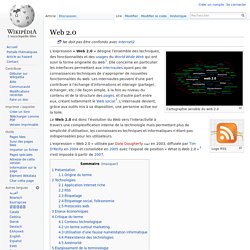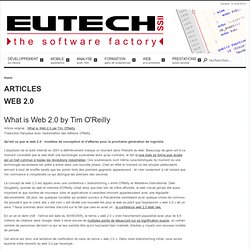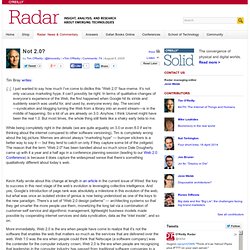

Web 2.0. Un article de Wikipédia, l'encyclopédie libre.

Cartographie sensible du web 2.0 L'expression « Web 2.0 » désigne l'ensemble des techniques, des fonctionnalités et des usages du World Wide Web qui ont suivi la forme originelle du web[1]. Elle concerne en particulier les interfaces permettant aux internautes ayant peu de connaissances techniques de s'approprier de nouvelles fonctionnalités du web. Les internautes peuvent d'une part contribuer à l'échange d'informations et interagir (partager, échanger, etc.) de façon simple, à la fois au niveau du contenu et de la structure des pages, et d'autre part entre eux, créant notamment le Web social[2]. L'internaute devient, grâce aux outils mis à sa disposition, une personne active sur la toile. L'expression « Web 2.0 » utilisée par Dale Dougherty (en) en 2003, diffusée par Tim O'Reilly en 2004 et consolidée en 2005 avec l'exposé de position « What Is Web 2.0 »[3] s'est imposée à partir de 2007.
Présentation[modifier | modifier le code] What Is Web 2.0. By Tim O'Reilly 09/30/2005 Oct. 2009: Tim O'Reilly and John Battelle answer the question of "What's next for Web 2.0? " in Web Squared: Web 2.0 Five Years On. The bursting of the dot-com bubble in the fall of 2001 marked a turning point for the web. Many people concluded that the web was overhyped, when in fact bubbles and consequent shakeouts appear to be a common feature of all technological revolutions. Shakeouts typically mark the point at which an ascendant technology is ready to take its place at center stage.
The concept of "Web 2.0" began with a conference brainstorming session between O'Reilly and MediaLive International. In the year and a half since, the term "Web 2.0" has clearly taken hold, with more than 9.5 million citations in Google. This article is an attempt to clarify just what we mean by Web 2.0. In our initial brainstorming, we formulated our sense of Web 2.0 by example: The list went on and on.
Eutech SSII. Article original : What is Web 2.0 par Tim O'Reilly .

Traduction française avec l'autorisation des éditions O'Reilly Qu'est ce que le web 2.0 : modèles de conception et d'affaires pour la prochaine génération de logiciels. L'explosion de la bulle internet en 2001 a définitivement marqué un tournant dans l'histoire du web. Beaucoup de gens ont à ce moment considéré que le web était une technologie surévaluée alors qu'au contraire, le fait qu'une bulle se forme puis éclate est un trait commun à toutes les révolutions industrielles.
Ces soubresauts sont même caractéristiques du moment où une technologie ascendante est prête à entrer dans une nouvelle phase. Not 2.0? Tim Bray writes: I just wanted to say how much I’ve come to dislike this “Web 2.0” faux-meme.

It’s not only vacuous marketing hype, it can’t possibly be right. In terms of qualitative changes of everyone’s experience of the Web, the first happened when Google hit its stride and suddenly search was useful for, and used by, everyone every day. The second—syndication and blogging turning the Web from a library into an event stream—is in the middle of happening. So a lot of us are already on 3.0. While being completely right in the details (we are quite arguably on 3.0 or even 8.0 if we’re thinking about the internet compared to other software versioning), Tim is completely wrong about the big picture. Kevin Kelly wrote about this change at length in an article in the current issue of Wired: the key to success in this next stage of the web’s evolution is leveraging collective intelligence. I guess it’s the old debate between language purists, and language pragmatists.